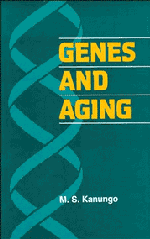7 - Conclusions and future prospects
Published online by Cambridge University Press: 22 March 2010
Summary
Biological research on aging is relatively a new field, at least in comparison to research on development. Nevertheless, its progress has been rapid, particularly during the last two decades, due to the utilization of sophisticated techniques of biochemistry, biophysics, molecular biology, and genetic engineering. However, aging is an enormously complex problem, as one has to examine a complex organization to find a few basic changes that cause aging. It is like looking all over a forest to locate a few worms that have started destroying the trees. In order to understand development, one proceeds from a relatively simple organization, step by step, to a complex organization. Development is like planting trees, both in space and time, to grow a forest. One can at least follow the steps. Though all the key steps of development are not yet deciphered, a few steps are beginning to be understood at the molecular level in certain organisms, such as how homeotic genes control segmentation in animals, how myoD gene regulates differentiation of skeletal muscle cell in vertebrates and how ced-3 and ced-4 genes cause the death of certain predetermined cells during the development of Caenorhabditis elegans.
During the past decade we have learned that the expression of several genes decreases after the attainment of reproductive maturity. The cause of such changes in expression of genes is being studied by analyzing specific sequences in their promoter regions, such as the DH-sites, methylation of cytosine and cis-acting elements, and the trans-acting factors that bind to these elements and modulate their expression.
- Type
- Chapter
- Information
- Genes and Aging , pp. 283 - 289Publisher: Cambridge University PressPrint publication year: 1994



